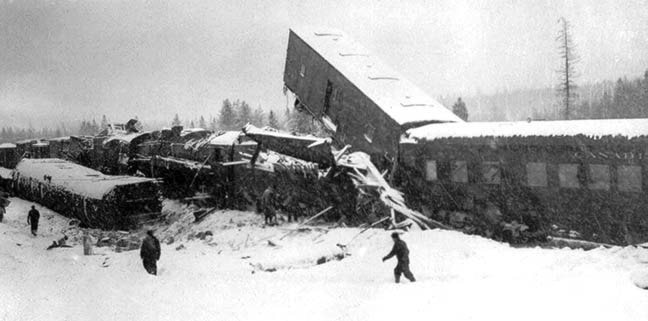Jim Cameron
The winter of 1949-50 was harsh by any standards. What had been a mild December began to turn as the New Year approached; one foot of snow soon became two while the temperature dropped from -9 F (-23 C) on January 1 to -37 F (-38 C) by January 3. The snow continued to fall, eventually reaching a depth of four-and-a-half feet. Although there was a full moon in early January, few ventured out to see it.
And so it was, in the cold, dark, early morning hours of Friday, Jan. 6, that a local freight engine pulled out of the CPR yard heading west. Its first destination was the nearby railway siding of Fassiferne, about seven kilometres west of town to await the scheduled passing of passenger train No. 12, heading through Cranbrook from the west.
Freight train No. 73 was under the control of five local men: engineer Peter Linton, freight conductor Charles Larson, fireman H. E. Hutton, head trainman (brakeman) P.E. Rowan and rear-end trainman (brakeman) William Myles.
The train was helped along the climb out of the Cranbrook yard by a "pusher" engine, although the term "puller" would have been more appropriate as the extra locomotive was at the front of the train. Once the freight was in place along the side track the pusher would be released and return to town.
Arriving at the siding on schedule, trainman Rowan, a six-week graduate from "student" to "qualified trainman," stepped into the blackness to cut the pusher free and switch the west line. At the same time, trainman Myles closed the rear end switch. The freight train was now safely on the siding with the passenger train cleared to pass on its way into the city.
Myles made his way to the front of the train to join Hutton and Linton in the cab while conductor Larson stayed in the caboose to do paperwork. Rowan entered the engine soon after.
"Is the switch lined up?" asked Linton. "Yes", replied Rowan.
It was not long before Hutton realized the eastbound train was approaching. He could clearly see the headlight reflecting in the surrounding air. Rowan also spotted it and cried, "Here she comes," as he jumped down from the cab between the two tracks to spot the passing engine number. Hutton went to the left door of the cab to do the same. He later recalled the approaching headlight "was like the sun shining in my face."
Passenger train No. 12, approaching from around a sharp curve to the west at a speed of about 35 mph, could see little as the train neared Fassiferne. Fireman Fortier could not spot the switch lamp nor could he see the switch "target" used to visually designate the switch setting. He was not alarmed until engineer Killins suddenly threw the brakes as the switch came into view. Killins had spotted the switch target signaling the wrong direction and hit the brakes about fifty feet away. Then, "I hung on," Killins stated. Fortier wasted no time in jumping from the racing engine through a side window.
Something had gone terribly wrong. The heavy passenger train followed the direction of the switch and plowed into the front of the idle freight locomotive, driving itself directly into the freight locomotive's oil tank and instantly killing engineer Linton. The flaming oil forced from the freight locomotive firebox enveloped trainman Myles as shock waves shattered the boxcars to the rear.
As the passenger train slowly ground to a halt, the body of a baggage car behind the engine slid off the tracks into a ditch to the left, leaving its wheels on the tracks. A second baggage car behind the engine landed on the east side of the tracks while a mail car ground relentlessly forward, eventually coming to rest jutting high into the frozen air. It was a rude awakening for many of the passengers, among them the Trail Smoke Eaters hockey team travelling to Kimberley for a weekend pair of games. Accompanying the team was their medical trainer who immediately set the players to work attending to the shocked and injured passengers. Unusual as it may seem, it was necessary to awaken passengers at the rear of the train who were completely unaware of the accident.
Fireman Fortier, suffering only minor injuries, returned immediately to the locomotive to find engineer Killins unharmed but trapped in his seat. Fortier passed him a crowbar and then rushed to the freight engine where he unsuccessfully attempted to extinguish the flames with a fire extinguisher. Killins pried himself free and immediately went to help pull Myles from the wreckage and place him in the snow to extinguish the flames. William Myles died on the scene.
Hutton, one moment standing in the doorway with "the sun shining in his face" awoke hanging by his feet from the engine, relatively unscathed. Rowan, on the ground at the time, regained consciousness while being tended by a Trail hockey player and was soon removed to the Cranbrook hospital suffering from leg and foot fractures. Medical teams soon arrived from town, having been called from a line telephone by conductor Larson immediately following the impact. Passengers, none of whom were severely injured, were ferried to town by Star Taxi.
Within the week a Cranbrook coroner's jury concluded: "We, the jury find ... that the accident resulted from an open switch and we attach negligence on the entire crew of train No. 73 [and further] that the west switch at the Fassiferne siding be removed to a site where greater visibility is assured."
And so it was in the cold, dark, early morning hours of Jan. 6, 1950.
